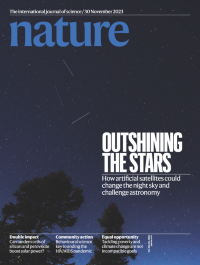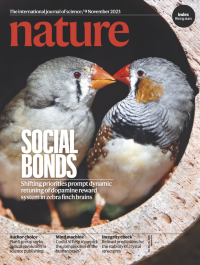Volume 623
-
No. 7989 30 November 2023
Outshining the starsGround-based astronomy is facing a challenge. Artificial satellites launched into low Earth orbit have essentially become brighter than most stars visible in the night sky. In this week’s issue, Sangeetha Nandakumar and colleagues report observations of one such object: BlueWalker 3, a prototype communications satellite launched on 10 September 2022 that has an antenna with a surface area of 64.3 m2. The cover captures trails left by satellites, including BlueWalker 3, as they pass across the sky. Combining professional and amateur observations from around the world, the researchers found that at its peak BlueWalker 3 was a bright as Procyon and Achernar (the brightest stars in the constellations of Canis Minor and Eridanus, respectively) and that it periodically becomes some 250 times brighter than the current International Astronomical Union recommendation. The team highlights that future satellite launches need to consider the potential effects on the night sky to avoid compromising ground-based astronomy.
-
No. 7988 23 November 2023
Beat generationThe heart is powered by filaments of the motor protein myosin, which pull on filaments of actin to cause muscle contraction. But the molecular structure of myosin filaments has remained elusive. In this week’s issue, two papers — one by Roger Craig and colleagues, the other by Stefan Raunser and co-workers — use cryo-electron microscopy to reveal the structure of these filaments in unprecedented detail. The results show how myosin interacts with two other proteins in the filaments — titin and cMyBP-C — and how its two motor domains (‘heads’) interact with one another to switch off their activity in the relaxed phase of the heartbeat. The cover image shows a slice of a myosin filament, with three different ‘crowns’ of heads at the surface, myosin ‘tails’ in the centre, and titin and cMyBP-C sandwiched between.
-
No. 7987 16 November 2023
Star systemMost animals have bilateral body symmetry — a head at one end, a tail at the other and a single axis of symmetry running from top to bottom. But echinoderms such as starfish and sea urchins are different: they have five-fold symmetry, with five limbs radiating from a central mouth. In this week’s issue, Laurent Formery and his colleagues reveal how this unusual body plan evolved. The researchers used RNA tomography to map gene-expression patterns in the bat star (Patiria miniata), pictured on the cover. They found that genes for head-like structures are expressed along the midline of each limb, and those that relate to tail-like structures are expressed in the small, tube-like feet on the edges of each limb. The starfish also lack genes that specify the trunk in bilateral creatures. As a result, the researchers suggest that echinoderms are mostly head-like animals.
-
No. 7986 9 November 2023
Social bondsHunger, thirst, loneliness and ambition all play a part in determining how much we value food, water, social interaction and our performance outcomes. Pulses of the neurotransmitter dopamine are released into the brain at moments of reward, but it remains unclear how these dopamine signals change when an individual’s priorities shift. In this week’s publication, Jesse Goldberg and colleagues explore the changes in dopamine signals in male zebra finches (depicted on the cover), as they engage in activities such as drinking, song evaluation and courting. The researchers found that dopamine responses are dynamically adjusted based on the birds’ current priorities. For instance, when focused on courting a female, their desire for water decreased, and the dopamine response to both water and song performance diminished. Instead, the male’s dopamine signals were driven by social feedback from the female. Importantly, female-driven dopamine release was observed specifically in a part of the male brain dedicated to social communication, revealing a new specificity and prioritization of social reward signals during courtship.
Nature Index
-
No. 7985 2 November 2023
Impact factorThe cover shows an artist’s impression of the collision between the protoplanet Theia and proto-Earth about 4.5 billion years ago. It has been suggested that it was this ‘Giant Impact’ that formed the Moon, but direct evidence for the existence of Theia remains elusive. In this week’s issue, Qian Yuan and his colleagues present combined results from simulations of the impact and mantle convection to explain why two large regions in Earth’s deepest mantle differ seismically and could be 2–3.5% denser than the surrounding mantle. The researchers suggest that the two dense areas are the remains of Theia’s iron-rich mantle that sank and accumulated above Earth’s core 4.5 billion years ago, surviving there throughout Earth’s history.
Spotlight





